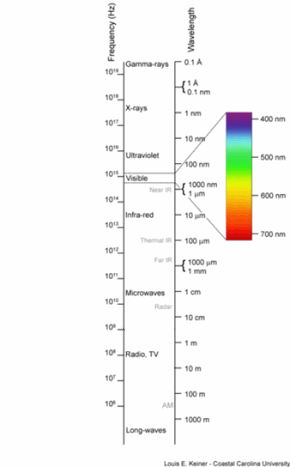


Similar term(s): Gamma rays, Radio waves, Visible light, Blue light, Infrared radiation, Ultraviolet radiation.
The electromagnetic spectrum is the entire range of wavelengths of all known electromagnetic radiations. It includes:
Gamma rays have the smallest wavelengths and highest frequencies known. They are high energy waves capable of travelling long distances through air and are the most penetrating waves.
X-rays have longer wavelengths than gamma rays but smaller wavelengths and therefore higher energy than ultraviolet radiation. They have been used in various applications in science and industry and are primarily used in medicine for instance in radiography. They are a form of ionizing radiation and as such can be dangerous. X-rays are emitted by electrons outside the nucleus, while gamma rays are emitted by the nucleus.
Ultraviolet (UV) radiation is defined as the portion of the electromagnetic spectrum between X-rays and visible light. More...
Visible light – also known as the visible spectrum – is the portion of the electromagnetic spectrum that human eyes can detect. It covers all colours from blue at 400 nm to red at 700 nm, with blue light having more energy than red light.
Infrared (IR) radiation – also referred to as thermal radiation – is the portion of the electromagnetic spectrum lying between visible light and microwaves. The most important natural source of infrared radiation is the sun.
Radio waves have long wavelengths, ranging from a few centimetres to many thousands of kilometres in length. They are used among other things for television, cell phone and radio communications.
Source: GreenFacts
Electromagnetic Spectrum

Source: Louis E. Kleiner, Coastal Carolina University
Frequency - Nanometre - Ultraviolet radiation
Deutsch: Elektromagnetisches Spektrum
Español: Espectro electromagnético
Français: Spectre électromagnétique